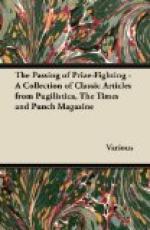* * * * *
SULLIVANHOE!
BRAVISSIMO, Sir ARTHUR SULLIVAN of Ivanhoe, or to compress it telegraphically by wire, “Bravissimo Sullivanhoe!” Loud cries of “ARTHUR! ARTHUR!” and as ARTHUR and Composer he bows a solo gracefully in front of the Curtain. Then Mr. JULIAN STURGIS is handed out to him, when “SULLIVAN” and “JULIAN”—latter name phonetically suggestive of ancient musical associations, though who nowadays remembers “Mons. JULLIEN"?—the composer and librettist, bow a duet together. “Music” and “Words” disappear behind gorgeous new draperies. “All’s swell that ends swell,” and nothing could be sweller than the audience on the first night. But to our tale. As to the dramatic construction of this Opera, had I not been informed by the kindly playbill that I was seeing Ivanhoe, I should never have found it out from the first scene, nor should I have been quite clear about it until the situation where that slyboots Rebecca artfully threatens to chuck herself off from the topmost turret rather than throw herself away on the bad Templar Sir Brian de Bois-Guilbert-sans-Sullivan. The Opera might be fairly described as “Scenes from Ivanhoe,” musically illustrated. There is, however, a continuity in the music which is lacking in the plot.
[Illustration: All Dicky with Ivanhoe; or, The Long and Short of it.]
The scenic effects are throughout admirable, and the method, adopted at the end of each tableau, of leaving the audience still more in the dark than they were before as to what is going on on the stage, is an excellent notion, well calculated to intensify the mystery in which the entire plot is enveloped.
The change of scene—of course highly recommended by the leech in attendance on the suffering Ivanhoe—from the little second-floor-back in the top storey of the castle tower, where the stout Knight of Ivanhoe is in durance, is managed with the least possible inconvenience to the invalid, who, whether suffering from gout or pains in his side,—and, judging by his action, he seemed to feel it, whatever it was, all over him,—found himself and his second-hand lodging-house sofa (quite good enough for a prisoner) suddenly deposited at the comparatively safe distance of some three hundred yards or so from the burning Castle of Torquilstone, in which identical building he himself, not a minute before, had been immured. So marvellous a flight of fancy is only to be found in an Arabian, not a Christian, Night’s Entertainment.
The Tournament Scene is a very effective “set,” but practically an elaborate “sell,” as all the fighting on horseback is done “without.” Presently, after a fierce clashing of property-swords, sounding suspiciously like fire-irons, Ivanhoe and Sir Brian come in, afoot, to fight out “round the sixth, and last.” There is refreshing novelty in Mr. COPLAND’s impersonation




